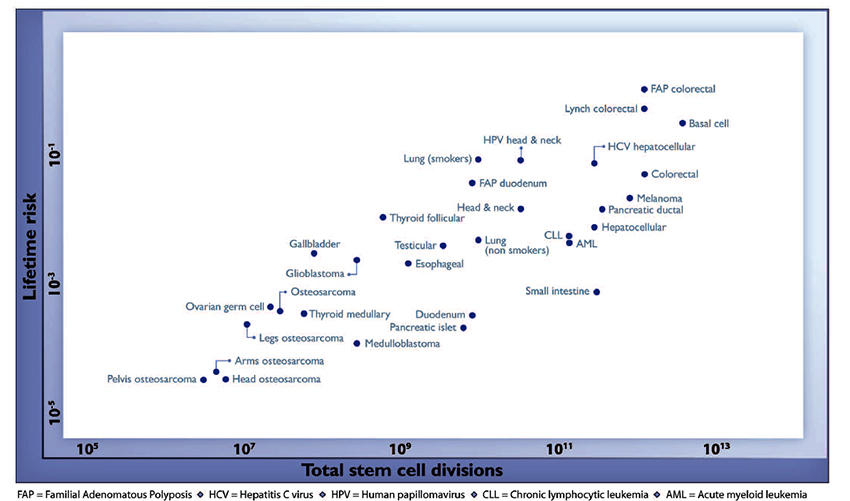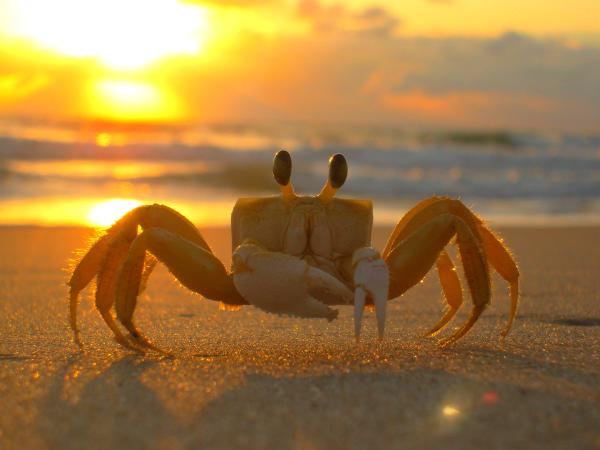But what happens if the cancer does not fall into one of the two known causes of cancer, heredity or the environmental/lifestyle factors? Until recently, people were left with no answers; many were racked with guilt over what they could have done differently to prevent cancer.
Bad Luck Theory
In 2015, the scientific world was shaken by a study based on cutting-edge information on the number of stem cell divisions in human organs. Information only then possible due to knowledge from the Human Genome Project when scientists mapped all of the genes of the human genome. The authors said a third factor explained cancer-causing mutations: random mutations (or mistakes) arising during DNA replication in normal, noncancerous stem cells. The number of stem cell divisions can explain variation in cancer risk among tissues.
A good explanation for how random mutations in stem cells work was provided by Dr. Francis Collins at the National Institutes of Health (NIH) as follows:
- Every time a cell divides, its 6 million nucleotides, the letters of our DNA, are copied, and each daughter cell receives a new copy.
- “Typos” inevitably occur during this process of duplication, but cells can pick up and correct most of these typos.
- However, a few typos invariably slip through and are not caught. If these typos occur in certain vital cells, it can lead to a mutation that causes uncontrollable growth and cancer.
Different organs within the body have differing numbers of stem cell divisions over a human’s lifetime. For example, the colon has many more stem cell divisions than the gallbladder. The authors hypothesized that those organs or tissues with the highest number of total stem cell divisions would also have the highest number of typos, scientifically, random mutations, which could result in cancer.
To test this theory, the authors identified 31 tissues within the body where the number and nature of stem cells had been quantified. They plotted the total number of stem cell divisions for that organ over a person's average lifetime and the lifetime risk for cancer of that specific cancer type. A highly positive correlation was observed.

What does this mean?
The organs with the highest number of total stem cell divisions also presented the highest cancer risk, while those organs with a lower number of total stem cell divisions had a lower cancer risk. This was consistent with the author’s hypothesis that the number of stem cell divisions was related to the number of random mutations resulting in cancer. The article concluded that these typos, the random mutations, could explain two-thirds of the variation in cancer rates in different tissues.
This was significant because it demonstrated a third possible factor responsible for causing cancer: the number of stem cell divisions in an organ. This has nothing to do with heredity or environmental factors; in fact, the authors used the term “bad luck” in the abstract to describe these random mutations occurring during stem cell division.
To people with a cancer diagnosis, it meant that there was an explanation for their cancer that did not involve their heredity, the environment, or their lifestyle – their cancer was simply due to “bad luck,” the random naturally occurring mutations due to stem cell divisions. This theory was particularly welcoming to parents of children with cancer who feel a great deal of guilt over what they “could have done” to prevent their child’s cancer. Here was a scientific theory that said it was not their fault! [1] While many parents were relieved, many in the scientific community had other thoughts.
“The International Agency for Research on Cancer (IARC), the World Health Organization’s specialized cancer agency, strongly disagrees with the conclusion of a scientific report on the causes of human cancer.”
“The Collegium Ramazzini condemns Tomasetti and Vogelstein’s remarks as dangerous to public health.” – the Collegium Ramazzini is an international scientific society concerned with environmental and occupational health
“The Tomasetti and Vogelstein article is dangerously misleading because it understates the role of prevention in cancer causation” – letter to the journal Science
Why was this controversial?
There were, as with all research, scientific limitations to the study pointed out by the critics:
- The article excluded, because of lack of data, common cancers such as those of the stomach and breast
- The study focused exclusively on the U.S. population
But much of the condemnation centered on the belief that this article would negate actions to prevent cancer: “The positions taken by Tomasetti and Vogelstein dismiss the significance of effects by government to identify and control exposure to carcinogens in the workplace, environment and the food supply. They also diminish the importance of decisions made by individuals to change lifestyle and diets to reduce exposures to known carcinogens.”
What Happened Next?
To their credit, the authors responded to the criticisms, publishing a follow-up article in 2017. Now they evaluated the incidence of cancer incidence in 69 countries and for 17 different cancer tissue types, including breast and prostate, which were not included in the first study. The results were remarkably similar to their first article. There was a strong correlation between cancer incidence and normal cell divisions in all countries, regardless of their environment. The authors concluded,
“The results accentuate the importance of early detection and intervention to reduce deaths from the many cancers resulting from unavoidable [random] mutations.”
Conclusions
Galileo was convicted of heresy and placed under house arrest by the church and shunned by his fellow scientists for his support of Copernicus’ Heliocentric hypothesis that the earth and all other planets revolve around the sun.
One has to wonder why a major cancer research organization such as IARC would condemn a scientific theory of cancer causation? A truly cutting-edge research center should embrace new ideas, not shun them. Although we like to think that the world has changed significantly since 1633, scientists still feel compelled to defend the status quo against theories threatening their worldview and perhaps their funding.
As we are entering an era that will be led by results from the Human Genome Project and Artificial Intelligence (AI), challenges will exist for more and more of our accepted theories in science. Will our institutions embrace change or continue to deny it, as is the current practice today? Will accusations of “conflicts of interest,” such as founding science-directed startups or serving on corporate, scientific advisory boards, be today’s version of a heretic?
[1] In fact, according to Tomasetti, one of the paper’s authors, he received over 200 emails from parents of children who had died of cancer who were grateful that it might have occurred by chance, suggesting that there was nothing they could have done.




